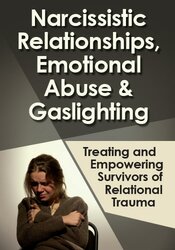5 Steps to Setting Healthy Boundaries
Strategies to Help Clients Break Free from Gaslighting & Narcissistic Abuse

Gaslighting is a form of emotional abuse in which one party manipulates another into doubting their thoughts, feelings, judgments, perceptions, and/or memories. The goals are to create doubt, undermine self-confidence, and cause victims to doubt their sense of reality and/or sanity.
This tactic is commonly seen in narcissistic, emotionally abusive, and coercive relationships.
Gaslighting in any kind of relationship undermines the victim’s ability to trust themselves, erodes their self-confidence, and convinces them to accept the gaslighter’s version of reality at the expense of their own. This abuse ultimately serves to empower the gaslighter and disempower the victim.
Gaslighting often reveals itself in phrases like:
Teaching your clients to recognize the tactics used by gaslighters is only one of the first steps towards recovery. You can also equip them with assertive responses to gaslighting tactics like:
However, in order to protect against further gaslighting, clients will need to learn to develop and maintain healthy boundaries. Assertive communication is part of the boundary setting process, but it is not the final step.
Amy Marlow-MaCoy, LPC,‚ÄØis a gaslighting expert and best-selling author of The Gaslighting Recovery Workbook: Healing from Emotional Abuse. In this quick video, she reveals the five steps you can take with your clients to help them effectively and assertively set boundaries:
5 Steps to Setting Healthy Boundaries
As you help your clients through treatment, it’s essential to remember that healing is a non-linear process. Boundary setting may seem simple, but these five steps are monumental for someone who’s experienced chronic emotional abuse and manipulation. However, we must remember that our clients are resilient, and that healing is possible.
This tactic is commonly seen in narcissistic, emotionally abusive, and coercive relationships.
Gaslighting in any kind of relationship undermines the victim’s ability to trust themselves, erodes their self-confidence, and convinces them to accept the gaslighter’s version of reality at the expense of their own. This abuse ultimately serves to empower the gaslighter and disempower the victim.
Gaslighting often reveals itself in phrases like:
- “I never said that.”
- “You’re overreacting.”
- “You’re just trying to make me look bad.”
- “That’s not how things happened.”
Teaching your clients to recognize the tactics used by gaslighters is only one of the first steps towards recovery. You can also equip them with assertive responses to gaslighting tactics like:
- “I know what I experienced.”
- “We remember that differently.”
- “I hear you, and that is not my experience.”
- “My emotions are not up for debate.”
However, in order to protect against further gaslighting, clients will need to learn to develop and maintain healthy boundaries. Assertive communication is part of the boundary setting process, but it is not the final step.
Amy Marlow-MaCoy, LPC,‚ÄØis a gaslighting expert and best-selling author of The Gaslighting Recovery Workbook: Healing from Emotional Abuse. In this quick video, she reveals the five steps you can take with your clients to help them effectively and assertively set boundaries:
5 Steps to Setting Healthy Boundaries
- Identify the client’s values. Is this about preserving their personal space? Do they want to make sure their emotions are not dismissed? The value determined needs to be something that’s important to the client; they need to be setting this boundary for themselves, not to make the clinician happy.
- Define the perimeter. Where is this boundary line? Help the client determine what kind of behaviors they can tolerate, and at what point they cross the line.
- Identify specific, problematic behaviors. Thinking back to the perimeter that’s been set, what specific behaviors are crossing it?
- Identify how the client will respond if the boundary is violated. Will they remove themselves from the situation? Will they step away from an unfinished argument?
- Follow through on the consequences. This is essential. If the client does steps 1 through 4 but doesn’t complete this final step, they’ll gain no ground.
As you help your clients through treatment, it’s essential to remember that healing is a non-linear process. Boundary setting may seem simple, but these five steps are monumental for someone who’s experienced chronic emotional abuse and manipulation. However, we must remember that our clients are resilient, and that healing is possible.
Discover More Strategies to Empower Survivors

This unique course lines up SEVEN of the foremost best-selling authors, researchers, and expert clinicians in the fields of narcissistic and psychopathic abuse, personality disorders, and emotionally immature people. Get the training to help your clients free themselves from the cycle of narcissistic and emotional abuse and gain control of their lives!
Meet the Expert:
Amy Marlow-MaCoy, LPC, focuses her practice on treating complex and developmental trauma in adults raised in narcissistic, emotionally immature, and toxic families of origin.
She is the author of the Amazon best-selling book The Gaslighting Recovery Workbook: Healing from Emotional Abuse (Callisto Media, 2020), a workbook designed to help individuals identify, understand, and begin to heal from emotional trauma and abuse caused by gaslighting in interpersonal relationships.
Amy has been trained in Level 1 Internal Family Systems therapy. She also provides supervision to LPC candidates and regularly consults with other clinicians regarding treatment of adult children of narcissists. She earned her Masters of Education in counseling psychology degree from Temple University.
Learn more about their educational products, including upcoming live seminars, by clicking here.
She is the author of the Amazon best-selling book The Gaslighting Recovery Workbook: Healing from Emotional Abuse (Callisto Media, 2020), a workbook designed to help individuals identify, understand, and begin to heal from emotional trauma and abuse caused by gaslighting in interpersonal relationships.
Amy has been trained in Level 1 Internal Family Systems therapy. She also provides supervision to LPC candidates and regularly consults with other clinicians regarding treatment of adult children of narcissists. She earned her Masters of Education in counseling psychology degree from Temple University.
Learn more about their educational products, including upcoming live seminars, by clicking here.



